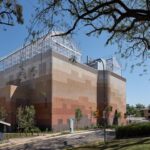FRP Composite Bars Emerge as Potential Game Changer
Fibre-reinforced polymer (FRP) composite bars have emerged as a potential game-changer for construction, particularly in concrete structures built around coastal areas, in aggressive environments and electromagnetic applications. Easy to transport, handle and assemble, these reinforcements are a sensible alternative when compared to heavyweight materials such as steel.

GALLERY
The sustainable qualities of construction materials are becoming equally important, resulting in a push for cement and concrete production processes with reduced carbon emissions.
FRP bars feature flexibility, high tensile strength and long durability and are non-corrodible. They are non-metallic and therefore won’t interfere with the operation of sensitive electronic devices. FRP bars have a lesser economic and environmental footprint than steel bars as the latter are energy-intensive to produce.
These properties make FRP bars a promising solution for reinforcing concrete elements like beams, columns, slabs, pavements and foundations to achieve a net-zero infrastructure.
The new standard, AS 5204:2023 – Fibre-reinforced polymer bars, published in December 2023, outlines the requirements for acceptable materials used in the production of glass and basalt FRP bars. These bars are employed for internal and non-prestressed reinforcement in concrete, whether in the form of straight or bent bars.
Additionally, FRP bars can also be a reinforcement option in concrete structures around electromagnetically sensitive areas.
As the construction industry evolves, leveraging these advantages will continue to be a consideration for construction professionals to optimise efficiency, reduce costs and their carbon footprint and ensure the longevity of their structures.
The benefit to builders with the revision to AS 3972 General purpose and blended cements, is that the changes give guidance on options for construction materials to enable them to offer what customers are looking for: cement and concrete that are geared towards net zero goals.
These changes will require the revision of Australian Standards to support changes to cements being used currently, to introduce low-carbon cements. It is estimated that changing the composition of the cement used will help reduce CO2 emissions by 2.5% by 2025, and by 10% by 2050, contributing to Australia’s targeted net zero goals by 2050.
Image from Grating FRP Australia.
Powerhouse Castle Hill has emerged as a vital hub for the Powerhouse Collection, supporting research, conservation, and public ...
In response to the growing pressures of climate change and population growth, the University of Queensland’s new Plant ...
In the lush bushland of Queensland’s Noosa hinterland, a sweeping veranda forms the heart of Cooroy House, an ...
Queenstown Events Centre has officially reopened its six outdoor netball and tennis courts following a significant rebuild, promising ...
For centuries, architecture has evolved in layers, with new structures built atop the old. While modern urban planning ...









